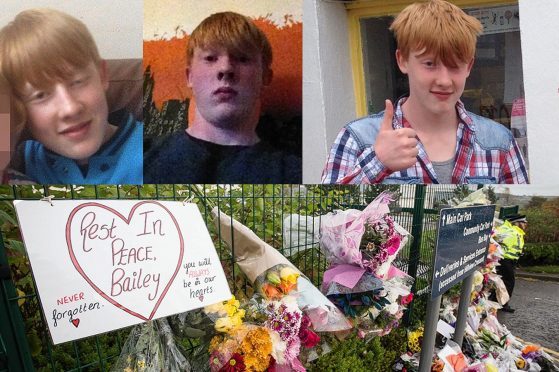The jury set to decide the fate of a schoolboy accused of murdering Cults Academy pupil Bailey Gwynne has been told not to let their emotions cloud their judgement.
This afternoon judge Lady Stacey is expected to send the jury of seven men and eight women out to consider their verdict after a week-long trial at the High Court in Aberdeen.
Bailey died on October 28 after suffering “catastrophic blood loss” from an injury he sustained when the 16-year-old accused’s knife penetrated his heart during a lunchtime brawl.
The teenager, who can not be named for legal reasons, admits killing Bailey in a “moment of anger” – but denies murder.
He further denies two other charges which claim he carried knives and knuckledusters to school on various occasions over a two year period.
This morning the court heard closing speeches from both the Crown and the defence.
Prosecuting, advocate depute Alex Prentice, QC, said to the jury: “I want to start by asking you a question, why do you think a young man would carry a knife and knuckle dusters?
“You would have to have a heart of stone not to be moved by the emotion of this trial but you must put emotion aside.”
Mr Prentice said the jurors had to be judges of the facts and said they must not be swayed by any emotion of the trial.
He said: “Like the young man in the dock and the plight he finds himself in, his family, his friends, school pupils at the school. That must form no part of your decision making.”
He also said not to let sympathy directed at Bailey’s family cloud their judgement.
Mr Prentice said there was sufficient evidence to find the accused guilty of murder. And he said it would be an “affront to justice” if they convicted him of the lesser crime of culpable homicide.
He said if they were convinced the accused carried the weapons then they should consider this when reaching there verdict on the murder charge.
He said: “There is little difficulty in relation to charges one and two and I ask you to convict on these charges.
“You are entitled to ask yourself, if you believe these items were carried, does this assist you in determining charge 3.
“My submission is it does. My submission is why on earth would you carry these things.
“Boys have carried pen knives for years, but why carry this knife and a knuckle duster if not to cause injury.”
But during his closing speech, counsel for the accused, Ian Duguid QC, said whether he carried a knife was “neither here nor there”.
He said the whole incident that led to Bailey’s death was over in 30 seconds. He said it was a “spontaneous event, a chance encounter.”
Mr Duguid said the accused displayed “extraordinary stupidity having a knife that day”.
But he said: “Bailey Gwynne displayed recklessness assaulting a fellow pupil over an assaulting remark. Who was the first to react?”
The QC put it to the jury that in order to convict the accused of murder they would need to be convinced that in the 30 seconds he “displayed behaviour which showed a state of mind, so wicked and depraved, to be that if a deliberate killer”.
Mr Duguid said: “Who was coming towards who? Because you know that Bailey Gwynne was coming towards the accused. The accused had not moved from his position, Bailey Gwynne had gone round the end of the wall.
“He was the one who turned back. He was the one who the accused saw in the reflection. He was the aggressor, maybe it’s not a nice thing to say because he’s deceased.
“The prosecutor said he had no chance if the accused had produced the weapon. If he saw the weapon he could have stopped. What was it that meant he did not stop? The answer is his aggression.”
Mr Duguid said that Bailey’s actions towards the accused “provoked” him to pull out the knife. He said if the jury agreed with this, having heard the evidence, they should feel they could convict the accused of culpable homicide and not murder.
He said: “A murder charge can be reduced to culpable homicide if there was an element of provocation. It was created in our law to take account for human frailties. We all experience reactions quickly, something the law is there to recognise.”
During the trial the court heard Bailey collapsed in a school corridor after walking 100 yards just after being stabbed through the heart following a row over a biscuit.
Witnesses said they watched as the tragic teen and the accused came to blows outside a toilet block after a remark was made about Bailey’s mother being “fat”.
The accused later told police he only meant to “scare” Bailey away when he pulled a knife from his blazer pocket and waved it at him.
The boy said that he had ducked down to protect himself as Bailey came towards him, with the knife held out in front of him.
He claimed he was unaware he had stabbed his fellow pupil until a teacher split them up and he noticed blood on Bailey’s shirt.
The court was shown a video recording of the interview the teenager gave to the police and when he was told he was being charged with murder he broke down and said: “I did try and save him.”
The jury previously heard evidence that the accused had been seen with a knife several times in school and that he had brought knuckledusters on to the premises “40 or 50 times”.
In his police interview the accused, who is also charged with being in possession of knives and knuckledusters while at the school, said he carried weapons with him “every day”.
He said he did it to “look cool” and to “look tough”.
He denies these charges.
Lady Stacey will charge the jury this afternoon.
